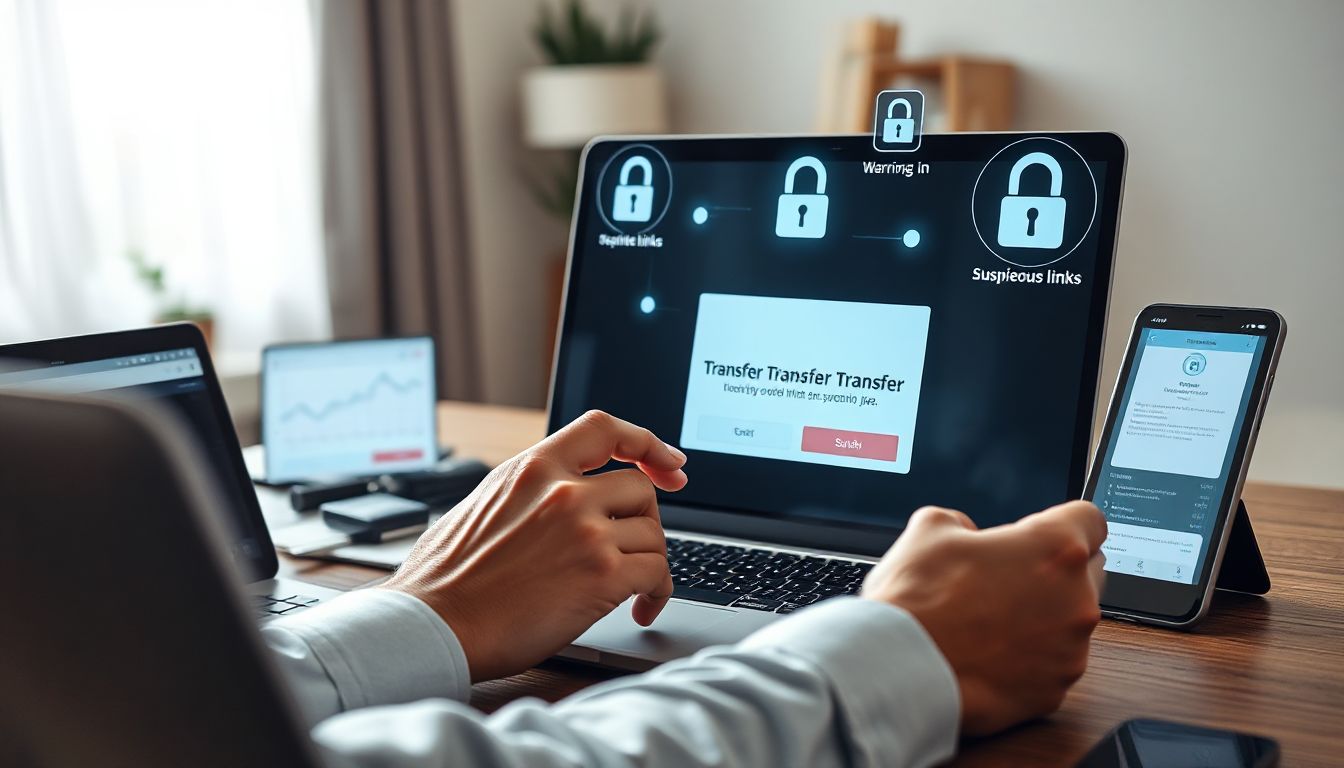Introduction
With more people moving money and data between devices and accounts, cybercriminals are getting smarter. Phishing attacks now target transfer activities because hackers know these moments are risky and full of sensitive information. Just last year, reports showed a 35% rise in scams involving fake transfer alerts, costing victims millions. Recognizing these scam tactics can save your bank account and personal data from falling into the wrong hands. Being alert isn’t just smart; it’s essential to avoid becoming a victim during these critical moments.
Understanding Phishing in Device and Account Transfers
What is Phishing?
Phishing is when crooks trick you into giving away private info. They use fake emails, messages, or websites that look real. Often, they copy legit companies to make their scams seem trustworthy. When transferring money or data, scammers send fake alerts to make you click malicious links or share info. They aim to steal login credentials, bank details, or personal ID.
Why Device and Account Transfers are Attractive Targets
Transfers are prime hacking targets because they involve moving sensitive data or money. Attackers want quick access to your bank accounts, emails, or cloud storage. Recent scams have used fake transfer requests from trusted contacts to get users to approve unauthorized moves. Imagine receiving an urgent email about a transfer from your boss, but it’s a scam; the damage can be done before you realize.
The Impact of Falling Victim to Phishing During Transfers
Getting caught by phishing scams can lead to hefty financial losses and identity theft. Hackers might drain your bank account or steal your social security number. Plus, you might face long-term problems like damaged credit or a ruined reputation. Protecting yourself during transfers isn’t just about money; it’s about safeguarding your entire digital life.
Signs of Phishing During Transfers
Unusual or Suspicious Communication
Watch out for generic greetings like “Dear Customer” instead of your name. Phishing emails often create a sense of urgency or use threats, such as “Your account will be closed tomorrow.” They might ask for personal info unexpectedly, even if you didn’t initiate a transfer.
Fake Transfer Notifications
Fake alerts look convincing but contain errors. For example, sender email addresses could contain odd domains or misspellings. The message might ask you to click a link or confirm details, which are signs of a scam. Always scrutinize transfer notices before trusting them.
Unrecognized or Unauthorized Transfer Requests
If you see transfer details from someone you don’t know or requests made outside normal hours, like in the middle of the night, be suspicious. Hackers often try to initiate transfers when they think you’re not paying attention.
Malicious Links and Attachments
Phishers love links that lead to fake login pages designed to steal passwords. They may also send attachments containing malware or keyloggers. Never open suspicious files or click on unfamiliar links, especially during transfer activities.
Pinpointing Fake Websites or Apps
Fake banking sites and apps can look just like the real ones but aren’t secure. Check URLs carefully; a missing “https” or extra characters could mean a scam. Also, look for the padlock icon in the browser bar to verify encryption.
How to Verify Transfer Authenticity
Confirming Identity Through Multiple Channels
When in doubt, call your bank or company directly using trusted contact info. Log in to your account via official websites, not links sent by email. Cross-reference transfer details with previous verified communications.
Checking the Authenticity of Notifications
Inspect sender email addresses closely. An authentic email from your bank will have a domain like yourbank.com, not a free email service. Always look for secure website indicators like HTTPS and the padlock icon before entering personal info.
Monitoring Bank and Transfer Account Activity
Regularly review your bank statements and activity logs. Set up alerts for large or unusual transactions. Quick detection can stop a scam from causing major damage.
Using Security Tools and Authentication Methods
Enable two-factor authentication whenever possible. Use biometric verification or security tokens for extra protection. These tools make it harder for scammers to access your accounts, even if they have your password.
Preventative Measures and Best Practices
Educating Yourself and Others
Stay informed on the latest scam tricks. Share tips with friends and family so everyone can recognize phishing attempts. Routine training on scam tactics keeps you sharp.
Implementing Technical Safeguards
Choose transfer platforms with strong security features. Use spam filters and anti-phishing tools to block fake emails before they reach you. Regular software updates also protect against vulnerabilities.
Establishing Transfer Protocols
Always verify transfer requests through independent channels. For example, if you get a transfer request email, call the requester directly. Set rules that require multiple approvals for big transfers.
Staying Informed on Latest Phishing Trends
Follow cybersecurity news and updates. Join online groups or forums about digital safety. Awareness of new tactics can help you stay one step ahead of scammers.
Conclusion
Spotting phishing attempts during device and account transfers isn’t complicated once you know what signs to look for. Suspicious emails, fake notifications, unrecognized transfer requests, malicious links, and website differences are all red flags. Always verify transfer details through trusted channels and keep your security tools active. Staying alert and informed reduces your risk of falling victim to these scams. Protect your money and personal info by adopting good habits today.
